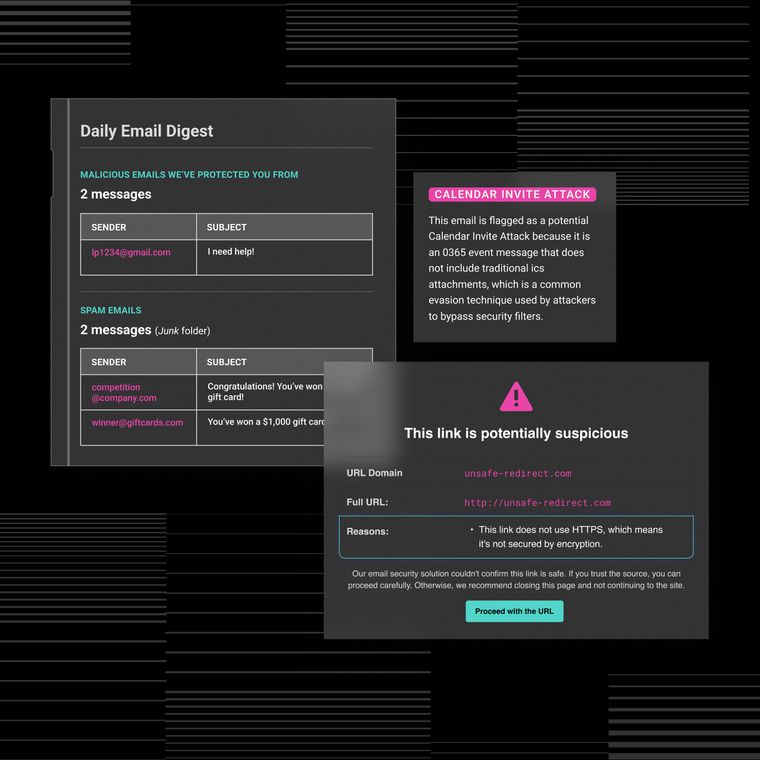Email Whitelist Strategies to Reduce Security Alert Fatigue
Use smart email whitelist strategies to cut down on alert fatigue while keeping your security defenses strong.
October 1, 2025
Misconfigured email whitelists create a dangerous paradox. They flood SOC analysts with thousands of false positives daily while simultaneously allowing real threats to slip through undetected. Every blanket approval adds noise that masks legitimate phishing campaigns, while compromised whitelisted addresses bypass filters entirely.
The dual impact cripples security operations. Analysts waste hours chasing benign alerts instead of investigating actual threats. Attackers exploit these blind spots to harvest credentials and establish a persistent presence. The inevitable outcomes include analyst burnout, extended breach dwell times, and complete erosion of trust in email defenses.
Smart whitelisting transforms this chaos into manageable protection. Here are seven strategies that demonstrate how to tighten approval policies, layer behavioral detection, and restore signal-to-noise ratios, keeping analysts focused on genuine threats rather than being overwhelmed by false positives.
1. Start with a Risk-Based Whitelisting Policy
Blanket whitelisting floods SOCs with low-value alerts while giving compromised senders free passes. Risk-based policies stop both problems before they start by requiring rigorous vetting before approval.
Every allow-list request requires four-point verification, including confirmation of a business need, domain age and ownership verification, current threat intelligence reputation, and a clean historical behavior within your environment. When any requirement fails, senders remain in normal filtering. Misconfigured tools amplify noise by treating partial matches as incidents, contributing to analyst burnout and missed attacks.
Behavioral profiles generate pre-approval risk scores, enabling quick acceptance of trusted partners and immediate rejection of suspicious domains. Document scores and require business sponsors to build dynamic, contextual allowlists that evolve with your risk landscape. This approach prevents the accumulation of stale entries, which can create both noise and security gaps.
2. Continuously Monitor Whitelisted Senders
Account takeovers remain significant threats when attackers hijack legitimate vendor accounts to bypass security controls. Trusted senders exhibit behavioral drift through suspicious deviations, such as logins from unfamiliar geographies, sudden changes in invoice amounts, or unusual attachment types.
VendorBase technology flags anomalies among allow-listed senders, transforming static lists into dynamic, adaptive policies. This approach reduces blind spots while keeping the mean time to detect compromised vendors within SOC service-level agreements. Continuous monitoring identifies potential threats without generating excessive alerts.
The key monitoring indicators include:
Geographic Anomaly Detection: Flag logins from countries where vendors have never operated, especially when combined with immediate payment change requests. These location shifts often indicate compromised credentials being exploited by foreign threat actors.
Communication Pattern Analysis: Detect changes in email cadence, language patterns, or typical business hours that suggest account compromise. Sudden urgency in previously routine communications signals potential social engineering attempts.
The real-time re-evaluation of trusted senders sustains resilient security postures. This proactive strategy addresses risks without overwhelming analysts with alerts, striking a balance between security and operational efficiency.
3. Don't Rely on SPF, DKIM, and DMARC Alone
Authentication protocols verify technical headers but don't authorize legitimate business communication. Treating them as equivalent floods SOCs with low-value alerts while sophisticated attacks slip through.
BEC actors demonstrate this gap daily. They register look-alike payroll domains, configure proper SPF and DKIM records, and pass DMARC validation. Emails appear technically legitimate, yet urgent tones and suspicious routing numbers reveal fraud. Meanwhile, teams are overwhelmed by alerts about minor header failures from legitimate vendors.
That said, the protocol limitations create blind spots, such as SPF technical constraints and DKIM authentication gaps. Language-aware AI and behavioral baselines layer over traditional header checks, detecting deviations like invoice spikes or location shifts even when authentication protocols pass. This contextual approach reduces false positives while surfacing alerts that analysts actually need to investigate.
4. Segment Whitelists by Business Function
Department-specific allowlists reduce attack surfaces while eliminating irrelevant alerts. Tool sprawl forces organizations to stack Microsoft 365 transport rules. For this, create discrete lists for finance, HR, sales, and customer support, mapped to specific mailboxes. Marketing automation platforms reach campaigns@company.co, for instance, but never payroll@company.com. Implement this model directly and then layer role-based policy scopes to enforce granular permissions.
When senders attempt routing outside designated segments, emails block and log without raising tickets. Regular audits keep lists aligned with business needs while maintaining analyst focus on relevant threats. Additionally, segmentation transforms chaotic rule collisions into organized, department-specific controls.
5. Automate Whitelist Maintenance
Automation transforms one-time email approvals from permanent blind spots into managed exceptions. Policy-driven workflows replace chaotic ticket queues while preserving analyst focus for real threats.
The process flows through discovery, analysis, and remediation phases seamlessly. SOAR platform integration enables automated expiration dates and threat enrichment, ensuring every whitelist entry undergoes review within defined intervals. When integrated properly, allowlist objects become trackable artifacts with service-level targets rather than forgotten exceptions.
Dashboards display compliance status while playbooks handle edge cases automatically. Trust revokes when senders appear in abuse feeds and restores when reputation improves. This orchestration creates unified audit trails instead of scattered email threads, preventing the same false positives from repeatedly flooding analyst queues. The result is sustainable whitelist management that reduces noise without creating security gaps.
6. Layer Whitelisting with Anomaly Detection
Behavioral anomaly detection eliminates whitelisting blind spots by enriching emails with context beyond sender trust. For instance, user and entity behavior analytics learns normal communication patterns for each relationship. The platform suppresses routine traffic while elevating significant deviations like new banking details from established vendors, unusual attachment types from trusted partners, login patterns from unexpected geographies, and invoice amounts outside historical ranges.
That said, it’s important to fine-tune thresholds for approved traffic tight enough to catch outliers yet loose enough to avoid flooding analysts. Continuous tuning backed by dynamic risk scoring keeps detection times within SOC goals while preventing static rule blind spots. Also, pairing allow-lists with behavioral monitoring reduces both false positives and negatives.
7. Establish a Regular Review Cadence
Quarterly whitelist audits keep allowlists lean while satisfying regulatory requirements. Every 90 days, export full lists, validate entries against active vendor contracts, and remove any outdated or unused information.
Cross-reference remaining senders with recent security incidents to ensure whitelisted domains haven't triggered investigations. Gather analyst feedback, as they are aware of which "trusted" addresses frequently flood dashboards with unnecessary alerts. Document all changes in immutable audit trails for SOX and GDPR compliance.
Making whitelist health a board-visible KPI ensures continuous funding for maintenance. Organizations enforcing quarterly reviews report measurably lower alert volumes and fewer security gaps. This disciplined cadence transforms ad-hoc cleanup into proactive risk management, preventing the accumulation of stale entries that create both noise and vulnerabilities.
Smarter Whitelisting Reduces Team Burnout
Unmanaged email allowlists create risks of missing genuine threats when attackers exploit trusted senders. Abnormal's behavioral AI offers dynamic layers that extend beyond static rules, learning and adapting to communication patterns for greater precision with fewer false positives.
These seven tactics directly address the challenges of alert fatigue, creating a resilient email security infrastructure that teams can trust. Implementing risk-based policies, continuous monitoring, and automated maintenance transforms chaotic alert queues into manageable, focused workflows.
Ready to reduce alert fatigue while strengthening your defenses? Get a demo to see how Abnormal can optimize your whitelisting strategy with behavioral AI.
Related Posts
Get the Latest Email Security Insights
Subscribe to our newsletter to receive updates on the latest attacks and new trends in the email threat landscape.


